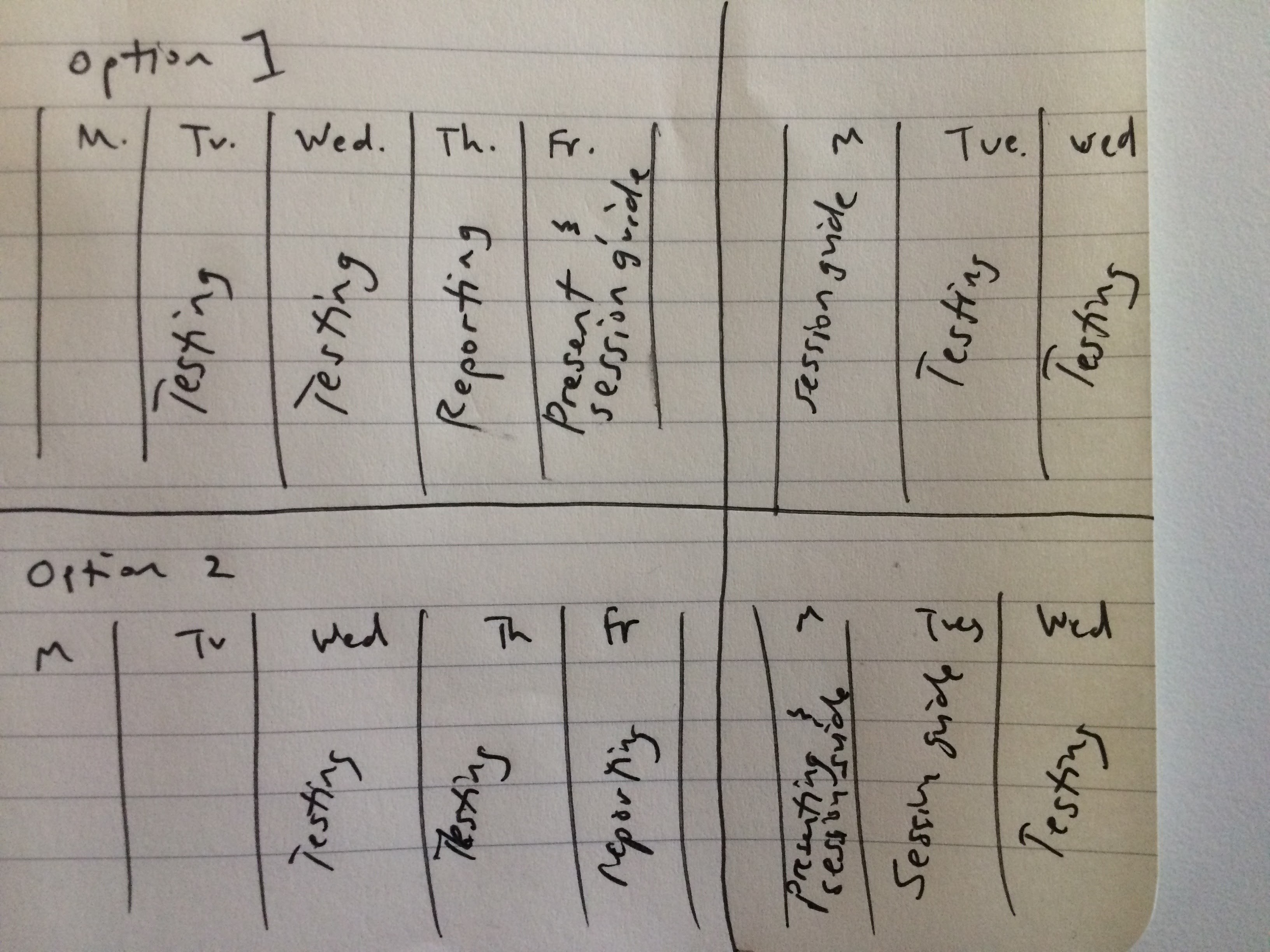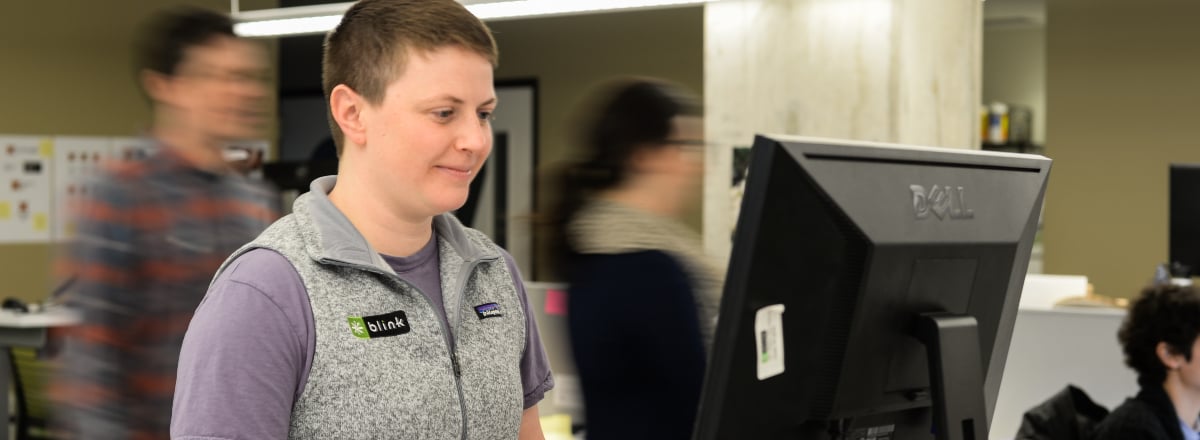
By
Katie Greiner
Back in 2020, a local startup asked me if I wanted to become an embedded employee to help the company build its user research program. The task was extensive and would require all my years as a researcher to accomplish.
Luckily, I had experience setting up a research program at my previous job at Zappos, so I raised my hand eagerly to be a part of this opportunity.
My task was to help the local startup develop research practices and procedures for their new user research team and program. Of course, this would require someone with UX expertise to help smooth the transition.
After four months of working at the startup, I learned valuable lessons that I’d love to share. So here are some of my recommendations for creating a solid research practice within a new company.
1. Understand the company’s needs
First, our team at Blink had a conversation with the client’s team to learn more about its user research needs. We discovered that the UX design team had been managing and running research studies, but this put a strain on company resources.
Ultimately, we were going to set up a more formal user research program. Still, in the meantime, there was an opportunity for us to engage and positively impact the business through a four-month, multi-study research program.
Recommendations
To help understand your company’s needs, start by searching for pain points in the current research process. Ask yourself: Where could your employees use more support? Which current methods are putting a strain on resources? The answers to these questions will lead you to a deeper understanding of your team's needs.
Once you understand your company's pain points, you can build short-term and long-term goals to address them and create a research program that aligns with your business needs. You should also define what a successful research program looks like to tailor your goals better and give your team something to work toward.
2. Make connections quickly
One of the first things I did when I started this multi-study project was identified my main point of contact at the startup. It was essential to establish a relationship with the person who could help me set and manage expectations with teams on the research schedule.
This relationship was significant once other teams started to see the research value and wanted their features and products tested. The additional research requests I received had to be funneled through my main point of contact since she was most familiar with the company’s goals.
In many companies, especially startups, product strategy will continually evolve and change. Therefore, I needed to check back with my point of contact to ensure I was up to date with the company’s latest strategic direction and how any changes might affect upcoming research studies. The research schedule that we defined at the beginning of the engagement was flexible to account for the changing pace of the startup environment.
Recommendations
Get connected with the business decision-makers early on. For example, talk with the person in charge of the product backlog and strategy to help define research goals and studies. You can also work with other team members to encourage greater connection and foster a shared understanding of your intended users.
With the help of your point of contact, you can build a flexible research plan that the team can adjust quickly to accommodate any strategic shifts in the future.
3. Share the benefits of research
To encourage discussions about the benefits of user research, I needed to get familiar with all the organization’s teams. So I was constantly introducing myself to new faces in the company. I talked to the project management, marketing, customer service, UX design, and development teams and got to know what questions they had about their users or features.
Additionally, this was my opportunity to talk with those who were not too familiar with user research and answer any questions they had about what user research was and its benefits. Building and maintaining an insight-driven organization is an all-company undertaking. Research findings not only benefited the user experience design and product management teams I was tasked to work with, but it impacted the entire company. Keeping this in mind, I frequently shared insights with others who had an interest in the results.
Recommendations
As your company begins to prioritize user experience research, getting everyone on board is essential. Help others see the value of UX research by:
- Sharing research findings throughout the organization consistently. Keep the research insights top of mind during introductions or casual conversations.
- Grabbing lunch or coffee with practitioners to learn about their role within the company. Use the time as an opportunity to discuss the benefits of user research.

4. Research their research
As a consultant, I had a unique standpoint as an unbiased third party in the company. I was not familiar with or aware of the internal opinions about the company’s product or strategy. So naturally, I was impartial when it came to product direction and internal processes.
Learning about the current research studies and company insights about the user and product was also important. One valuable exercise was interviewing stakeholders about what research deliverables or processes had worked well and what had not met expectations in the past. With a few simple questions, I learned a ton about the current methods.
I also questioned if or how the client currently documents and shares insights. Research is most effective when it is actionable and shared. Getting teams on the same page with how users understand and use a product is imperative for a well-defined strategy.
Recommendation
Be bold with your suggestions for improving internal processes or documentation. Remember, you have an unbiased perspective to share.
5. Become familiar with their internal practices
It was also beneficial to get access to Slack, the client’s internal messaging system. As a result, I was able to join relevant conversations, which helped me understand the project better.
Luckily, my desk was situated right by the feature teams’ standups area and a large whiteboard where UX designers, project managers, and developers often congregated for brainstorming sessions. Thus, I was ideal for answering any research questions or joining conversations about usability studies.
Recommendations
When developing a UX research program and overseeing qualitative and quantitative research, immerse yourself in the company culture and office space. This will help you build a cohesive team and ensure that your staff can easily ask questions or brainstorm with you when needed. To do this, we recommend that you:
- Consider where your desk is and its impact on the frequency and types of conversations you could have.
- Figure out where you can embed yourself into existing processes to bring the most value.
- Think outside the box if you have remote workers or multiple offices. For example, try to schedule "field trips" or retreats once a quarter to bring people together and build relationships across the entire company. Video calls are also a great option if an in-person meeting is not available.
6. Set clear expectations and implement processes as needed
Since the UX designers were under-resourced and managed several projects, communicating realistic expectations on when I needed the prototypes finalized for usability testing was necessary. I worked backward from the testing date to get familiar with the prototype and write up a session guide with questions. I also worked closely with the UX designers to ensure we were creating specific user flows that would help us answer our research questions.
I had to educate teams about the tradeoffs between delivery time and the extent of reports. For example, I could write up a topline report with video clips in a day, but I had to adjust the timeframes and set those expectations if more analysis was needed.
For this particular client, it was essential to get the findings out quickly for the UX design and development teams to start iterating and developing. Therefore, I made sure to provide an executive summary and thorough recommendations in the topline reports for those who could not attend sessions and needed to catch up quickly on key findings.
Recommendations
To ensure that your team meets expectations, regularly communicate with UX designers about what prototypes or artifacts you’ll need for usability testing. If your staff needs time to become well-versed with the prototypes, set deadlines to give them a timeframe to work with and stay on track. You can also write a session guide with pertinent questions and answers.
7. Be transparent and accessible
Regardless of the feature being tested, I invited the larger product team to watch the usability sessions live. For those who were unable to attend the user research sessions, I sent them a link with the session video files to watch the session at their convenience.
Video clips served as a great way to share information with team members who could not attend the sessions. The video clips needed to be easily accessed and uploaded in a shared place for others to view. Uploading the videos to Google Drive and linking to specific spots in the video was efficient and effective.
Recommendations
To foster a culture of transparency and ensure that practitioners have access to key information, follow these tips:
- Get as many people to observe the usability sessions as you can. Ensure that people know when these usability sessions are happening in advance, and encourage in-person attendance.
- Always record your usability session. Timestamp important moments from the video so that users can find relevant information quickly.
- Share your findings with the broader company to encourage discussion and critique. Discussing the research findings with others in the company will lead to more ideas and make team members feel like their input is valuable when crafting effective solutions.
8. No insights left behind
I became very invested in the company and wanted its teams to be set up for success after completing my multi-study project. I had the opportunity to talk with many users over my project timeframe and gained a clear picture of their needs, wants, and frustrations. I needed to make sure the company had all of these insights as well.
My first step was to organize all the files I had generated and put them in an accessible location for everyone to view. Next, all of my session notes, session guides, recordings, and reports were organized and put into the company’s shared drive. This ensured that everyone at the company had access to the documents.
One of my last deliverables, which I’m hopeful will help the company continue research discussions, was to create a set of user personas for the company. Personas document users’ behaviors, perceptions, and motivations and help get teams and companies on the same page to identify their users.
I created these lightweight personas from the interviews I conducted during my engagement. Even though each study tested a specific feature, I asked general questions about the product to analyze trends from all the interviews to feed into the personas. The personas also provided an excellent summarization of key findings and high-level themes from the past months of research. It could serve as inspiration for future research studies outlining the personas’ frustrations about the current product.
Recommendations
To ensure your team gets the most out of the research, follow these steps:
- Summarize and share insights from research studies often.
- Ensure that people have access to research on shared drives and other locations.
- Think of ways to document trends and recurring themes from multi-study projects. Synthesize themes in the form of personas to give teams a quick overview of how their users think and behave with their product.
The result of a focused UX research development program
Over four months, I was humbled to see the excitement for user research grow throughout the company. The more my team discussed and shared research findings, the more I started seeing and hearing a shift in how teams thought about problems and solutions.
Every conversation should keep the user front and center. Most importantly, remember to get teams involved early and often with user research to impact the company. This experience taught me to continue asking questions to expand on insights, improve processes, and learn more about the users, product, and company.
Take your research program to the next level
At Blink, we believe that evidence is the most powerful design tool. As such, we are always thinking about how a customer will use a client's product or service. With our team by your side, you'll have access to evidence-driven data to inform your designs. In addition, our experience working with a diverse array of clients means that we have a wealth of information to draw from as we help you build an in-depth research program and create experiences for your customers that reflect your core brand.
Ready to get started? Contact us today.
When not asking lots of questions and observing how humans behave, you can find Katie capturing time-lapses of the city or telling colleagues about the upcoming Seattle Reign soccer games she’ll be attending.



